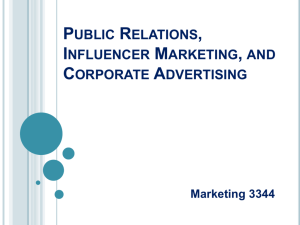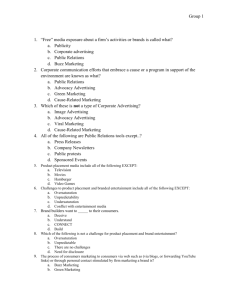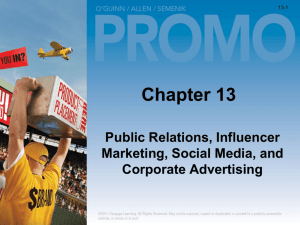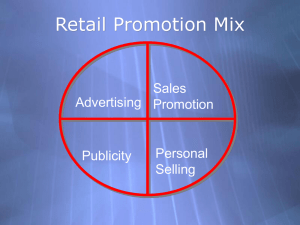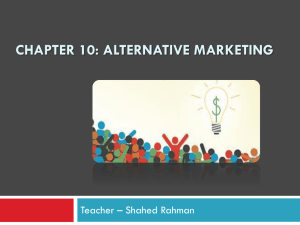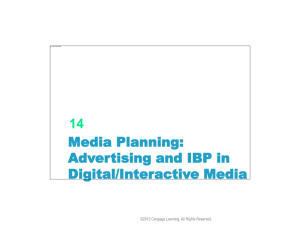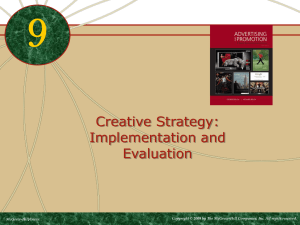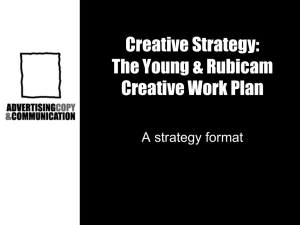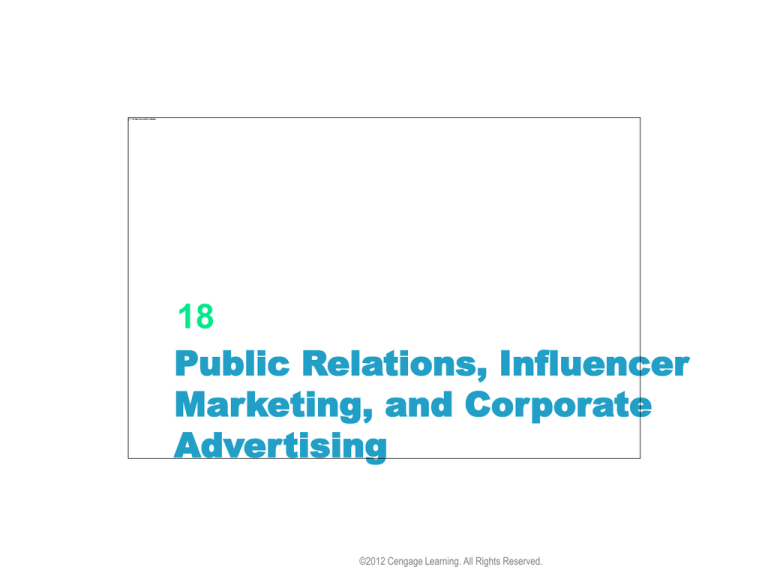
18
Public Relations, Influencer
Marketing, and Corporate
Advertising
©2012 Cengage Learning. All Rights Reserved.
Introductory Scenario:
Bring on the Buzz
Procter & Gamble creates buzz for Charmin
• Enjoy the Go! Campaign
• A dozen support agencies involved
• Created on site “go teams” who
greeted visitors but were also screened
for social media skills
• Celebrities get into the act
• Sponsor a Broadway show and get
news media involved—TV, newspaper,
blogs
Public Relations
The marketing and management
communications process to foster goodwill
between a firm and its constituents:
• Customers
• Stockholders
• Suppliers
• Employees
• Government entities
• General public
A New Era for Public Relations?
Firms are using PR in new and different ways
to create visibility and image for a brand by
getting people to “talk” about the brand.
BUT…
• PR is NOT the tool for establishing brands in the
market.
• PR lacks the strategic control needed to establish a
brand within the segment in the manner desired by a
firm.
• It is true that corporate execs want more “action” and
visibility from promotion. PR is now more prominent
in many IBP campaigns as consumer tire of mass
media advertising.
• Good PR can create a positive social “epidemic.”
© 2000 JABRA Corporation
The cellular phone
industry has had to
combat the bad
“PR” from distracted
driving incidents
related to cell phone
use while driving.
Public Relations and Damage Control
• Intel—Caused its own PR crisis by not
responding to concerns about the
performance of the Pentium chip.
• Taco Bell and the PR “curse” of social
networking.
• Walmart in nearly constant damage
control.
• But, companies need to learn to handle
bad news.
Objectives of Public Relations
•
•
•
•
•
•
Promote goodwill
Promote a product or service
Prepare internal communications
Counteract negative publicity
Lobby
Give advice and counsel
Tools of Public Relations
•
•
•
•
•
•
Press releases
Feature stories
Company newsletters
Interviews and press conferences
Sponsored events
Publicity
Public Relations Strategies
• Proactive PR strategy
o Guided by marketing objectives
o Publicize a company and its brands
o Take an offensive rather than
defensive posture
• Reactive PR strategy
o Dictated by external influences
o Focuses on problems, not
opportunities
o Requires defensive measures
Proactive Strategies
• Public relations audit
• Public relations plan
o Current situation analysis
o Program objectives
o Program rationale
o Communications vehicles
o Message content
Reactive Strategies
• Public relations audit
• Identification of vulnerabilities
Influencer Marketing
• A series of personalized marketing
techniques directed at individuals or
groups who have the credibility and
capability to drive positive word-of-mouth
in a broader and relevant segment of the
population.
• The idea is to give the influencer
something positive to talk about with
respect to firms and brands.
Professional Influencer Programs
• Targeting professionals (doctors, therapists,
lawyers, accountants, etc.) with positive PR
messages with goal of having these
“professionals” influence their clients attitude
toward a brand.
• “Seeding the conversation” between the
professionals and their clients.
• Tactics include trade show displays, direct
mail communications, and personal selling
calls—all IBP techniques.
• The process provides professionals with
“intellectual currency.”
Peer-to-Peer Influencer Programs
• Targeting social networks with
positive messages about a brand to
pass along through their social
networks.
• The programs provide “social
currency” within peer networks.
• Buzz and Viral Marketing
Peer-to-Peer Influencer Programs
Buzz and Viral Marketing
•
Buzz marketing is creating an event or experience that yields
conversations that include the brand.
•
Viral marketing is the process of consumers marketing to
consumers via:
– The Web (e.g., via blogs, social media, or forwarding YouTube links)
or through personal contact. Simulated by a firm marketing a brand.
– The idea behind both buzz and viral marketing strategies is to target a
handful of carefully chosen trendsetters or connectors as your
influencers, and let them spread the word.
•
Cultivating Connectors
– The sophisticated process of cultivating peer-to-peer influencers to
positively tout a firm’s brand.
– Procter & Gamble has enrolled 600,000 “connectors” in its Vocalpoint
program—mostly women with wide social networks.
Corporate Advertising
Designed to establish a favorable
attitude toward a company as a whole.
Objectives:
• Build the image of the firm
• Boost employee morale or attract new
employees
• Communicate an organization’s views
• Position the firm’s products
• Play a role in integrated brand promotion
Courtesy BMW
Corporate
advertising
features the firm
rather than one
of the firm’s
brands.
Types of Corporate Advertising
• Corporate image advertising: Create a
favorable predisposition toward the firm—not
designed to affect sales.
• Advocacy advertising: Establish the firm’s
position on important social, political or
environmental issues.
• Cause-related advertising: Features a firm’s
affiliation with an important social cause.
• Green Marketing: Corporate efforts that
embrace a cause or a program in support of
the environment.
Courtesy, Miller Brewing Co.
Drinking and driving is an important
Social issue prompting corporate
cause advertising.

